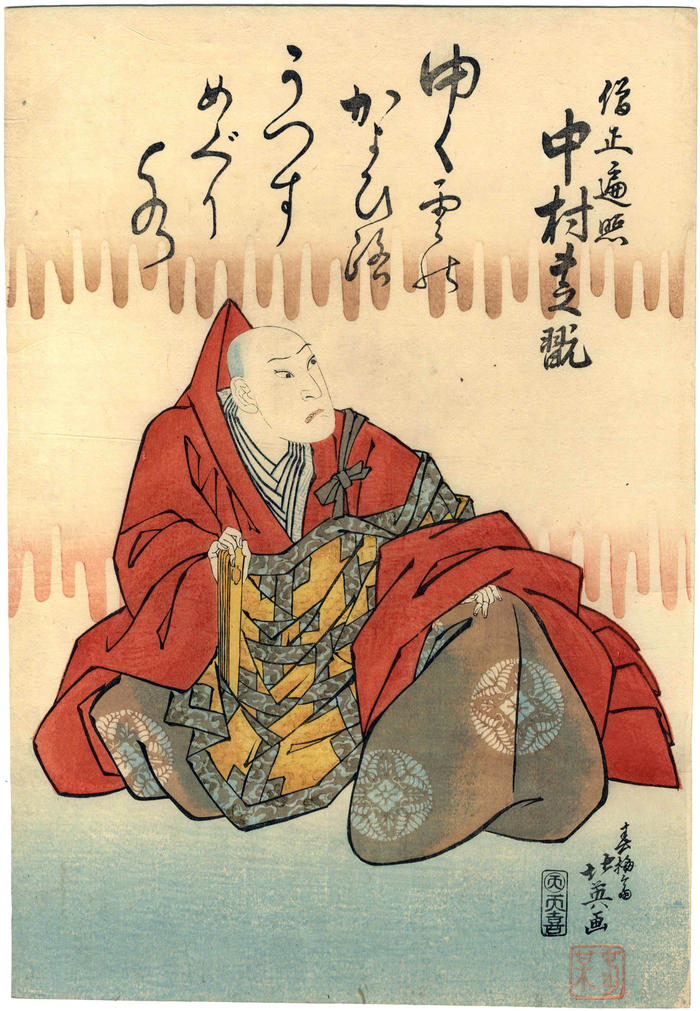Shunbaisai Hokuei (春梅斎北英) (artist )
Nakamura Shikan II (中村芝翫) as Sōjō Henjō (僧正遍照) from 'Colorful Forms of Six Immortal Poets' (Rokkasen sugata no saishiki - 六歌仙容彩) - one panel of a hexaptych
01/1834
10.5 in x 15 in (Overall dimensions) Japanese woodblock print
Signature: Shunbaisai Hokuei ga
春梅斎北英画
Artist's seal: Shunbai
Publisher: Tenmaya Kihei (Marks 536 - seal 21-0193)
Museum of Fine Arts, Boston
Kansai University
Metropolitan Museum of Art - Buddhist's vestment or kesa
Museum of Fine Arts, Boston - 19th century kesa
Museum of Fine Arts, Boston - Utamaro print of a beauty with an inset of Sōjō Henjō
Lyon Collection - Shigeharu print of the 6 poetic sages This is from a from a quick-change dance or 'transformation piece', an hengemono. The 'quick-change technique' is referred to as a hayagawari (早変わり). According to John Fiorillo: "It was first performed by Nakamura Shikan II in Edo in 3/1831, and brought to Osaka two months later after Shikan ended his sojourn Edo in the fall of 1833. (The Edo play title is read Rokkasen sugata no irodori with the same characters.) In his performance of five roles, Shikan demonstrated his skill as an "all-around actor" (kaneru yakusha). Nakamura Baika (Tomojūrō II's poetry name) performs the sole female role for all five dances."
Fiorillo notes of this dance that "The first section portrays the elderly Buddhist monk Henjō vainly attempting to seduce Ono no Komachi, who urges him to seek salvation, not passion."
Quoted from: Hokuei: Master of Osaka Kabuki Prints, page 94.
****
According to the entry in the The Princeton Companion to Classical Japanese Literature on p. 163 Henjō (816-890?) was not really that significant a poet. However, he is considered so because he was listed with five other poets in Ki no Tsurayuki's preface to the Kokinshū "...and is included as well as one of hte thirty-six poetic worthies (sanjūrokkasen)."
****
There are at least two prints in the Lyon Collection which portray Sōjō Henjō. The other print is by Shigeharu, #574, and it shows a grouping of all six poets from the same kabuki production.
Notice that part of the priest's robe or kesa (袈裟) is made up of patched fabrics. In reference to a kesa in the collection of the Metropolitan Museum of Art it says:
This robe, an example of a Buddhist vestment (Japanese: kesa; Sanskrit: kashaya) meant to distinguish the clergy from laypersons, is made from a woven textile that was cut up and reconfigured into a rectangular, bordered patchwork. As such, these garments embody both a form of pious donation and the practice of recycling textiles. The labor-intensive practice of piecing together fragments of cloth into specific columnar layouts was itself considered an act of religious devotion.****
Sōjō (僧正) means 'high Buddhist priest'.
****
Bibliography: Kitagawa, "Bosuton bijutsukan shozô Kamigata-e mokuroku" (Kansai daigaku, 2007), p. 101; Kitagawa et al 2006, #6; referenced in Keyes 1973 on p. 134.
****
According to a Kansai University pdf, item #6, this print should be considered as one of a pair with a print of Ariwara no Narihira (在原業平).
****
Illustrated
1) in color along with the other five prints in the set in Hokuei: Master of Osaka Kabuki Prints by John Fiorillo, Ludion, 2024, cat. 150, page 95.The set is also illustrated in color in smaller images on page 177 with additional information. For example: Fiorillo says the seal on this print should be read as 'Shun'ei' (春英), while the Museum of Fine Arts says it should be Shunbai. It is sealed with 'Hokuei' (北英) on one print, but not this one. Three different publisher seals appear on this set: Honsei (本清) on two of them, Tenki (満喜) on two and Wataki (綿喜) on the other two.
2) in color in Kabuki Heroes on the Osaka Stage, 1780-1830 by Andrew Gerstle, University of Hawai'i Press, 2005, #274d, page 290. The image shown is from the Gerhard Pulverer Collection.
Tenmaya Kihei (天満屋喜兵衛) (publisher)
Kyōto-Osaka prints (kamigata-e - 上方絵) (genre)
actor prints (yakusha-e - 役者絵) (genre)
Nakamura Shikan II (二代目中村芝翫: 11/1825 - 12/1835) (actor)
